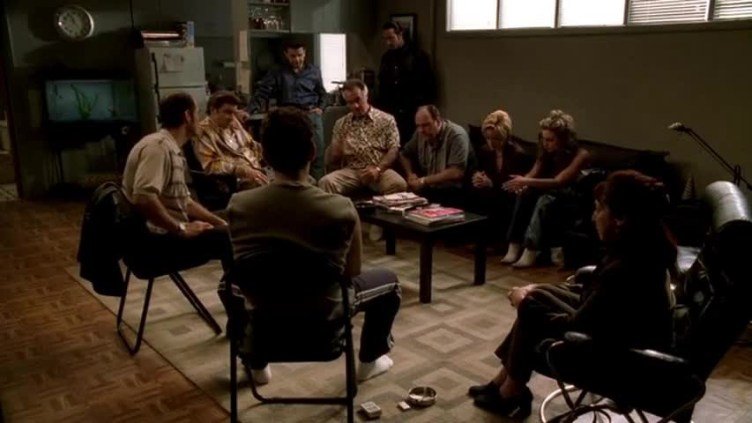Television Review: The Strong, Silent Type (The Sopranos, S4X10, 2002)

The Strong, Silent Type (S04E10)
Airdate: November 17th 2002
Written by: Terence Winter, Robin Green & Mitchell Burgess
Directed by: Alan Taylor
Running Time: 53 minutes
Following the visceral shock of Whoever Did This—an episode defined by Ralph Cifaretto’s grotesque murder and the disposal of his dismembered body—the fourth season of The Sopranos faced the narrative challenge of recalibrating its tone. How does a series steeped in moral ambiguity and brutal realism sustain momentum after such a seismic event? The Strong, Silent Type answers this by leaning into the show’s signature blend of irony and psychological nuance. While inherently anti-climactic compared to its predecessor, the episode thrives not through explosive drama but via a quieter, darker humour, dissecting the fallout of trauma, addiction, and the fragile mythologies of masculinity that underpin Tony Soprano’s world.
The episode’s central irony lies in its mirroring of prior violence: just as Ralph’s killing of Tracee, the Bada Bing dancer, and the racehorse Pie-O-My catalysed Tony’s murderous rage, here, another innocent animal’s death—Adriana’s dog, Cosette, accidentally suffocated by a heroin-addled Christopher—serves as the catalyst for chaos. Christopher’s descent into addiction, long foreshadowed, reaches a nadir. Even Adriana’s FBI handler, cynically exploiting her vulnerability, suggests rehab—a moment that underscores both the absurdity and tragedy of their lives. Christopher’s denial is monstrously self-destructive: carjacked and beaten while chasing a fix, he responds to Adriana’s pleas with violence, a harrowing illustration of addiction’s dehumanising grip.
The intervention scene, a darkly comic centrepiece, teeters between farce and horror. Tony’s crew—Paulie, Silvio, and even a reluctant Bobby—enlist Dominic Palladino (played by wonderfully slimy Elias Koteas), a recovering addict turned self-righteous “interventionist,” to confront Christopher. The sequence unravels into chaos, with Palladino’s sanctimony clashing against Christopher’s rage, culminating in a brutal beating. Yet the episode’s bleakest punchline arrives later: Tony, ever the pragmatist, offers Christopher rehab with a mafioso’s ultimatum—“If you use again, I’ll kill you myself.” The threat, hollow in its paternalistic cruelty, underscores the show’s nihilistic worldview: even salvation here is transactional, laced with violence.
Years later, the scene gained morbid resonance. Christopher’s barbed critique of Tony’s gluttony—“You’re gonna have a heart attack by the time you’re 50!”—proved grimly prophetic. James Gandolfini, whose physicality and vulnerability defined Tony, died of a heart attack in 2013 at 51. The line, once a throwaway jab, now hangs over the episode like a ghost, a testament to the series’ uncanny ability to blur fiction and reality.
Ralph’s disappearance forces Tony into damage control. His feigned ignorance—“Maybe the Lupertazzis whacked him over that joke about Ginny Sack?”—is a transparent lie, yet one his crew tacitly accepts. The brilliance of this subplot lies in its subtlety: though no one explicitly accuses Tony, their sidelong glances and loaded silences speak volumes. Paulie’s fixation on a kitsch portrait of Tony and Pie-O-My—commissioned as a gift—becomes a symbol of the crew’s unspoken suspicions. The painting, garish and absurd, mirrors the hollow iconography of Tony’s leadership: a “strong, silent type” whose authority rests on fear, not respect. While the subplot occasionally veers into heavy-handed symbolism (Paulie’s art critique feels overly contrived), it underscores the episode’s thematic core—the fragility of Tony’s facade.
The title, referencing Gary Cooper’s stoic Hollywood archetype, becomes a vicious joke. Tony’s idolisation of Cooper—a man who “settled things with a look”—is undercut by his own bluster and insecurity. The true “strong, silent type” emerges in unexpected places: Furio, whose return to America is marred by repressed desire for Carmela, embodies a quieter, more tragic masculinity. Their unspoken attraction—Carmela confessing her feelings to Rosalie, Furio silently tending to her garden—contrasts sharply with Tony’s crude machismo. Similarly, Svetlana, Uncle Junior’s no-nonsense Russian caretaker, captivates Tony not through seduction but stoic competence. Their affair, born of mutual pragmatism (and Svetlana’s prosthetic leg, treated with matter-of-fact dignity), mocks Tony’s romantic delusions. In both relationships, the episode deconstructs the myth of the alpha male, revealing vulnerability beneath the posturing.
While The Strong, Silent Type excels in character study, its subplots occasionally strain. Paulie’s art obsession, while darkly funny, feels overly schematic—a writerly metaphor for Tony’s crumbling mythos. Yet these missteps are minor in an episode so rich in psychological detail. The writing crackles with acidic wit and the ensemble cast—particularly Michael Imperioli’s raw, agonised Christopher—delivers career-best work.
In retrospect, the episode epitomises The Sopranos’ genius: a mosaic of moral decay, laced with irony and foreshadowing, where even the throwaway lines echo with unintended prophecy. It is a reminder that in Tony’s world—and perhaps our own—the strongest silences are those filled with everything left unsaid.
RATING: 7/10 (+++)
Blog in Croatian https://draxblog.com
Blog in English https://draxreview.wordpress.com/
InLeo blog https://inleo.io/@drax.leo
InLeo: https://inleo.io/signup?referral=drax.leo
Hiveonboard: https://hiveonboard.com?ref=drax
Rising Star game: https://www.risingstargame.com?referrer=drax
1Inch: https://1inch.exchange/#/r/0x83823d8CCB74F828148258BB4457642124b1328e
BTC donations: 1EWxiMiP6iiG9rger3NuUSd6HByaxQWafG
ETH donations: 0xB305F144323b99e6f8b1d66f5D7DE78B498C32A7
BCH donations: qpvxw0jax79lhmvlgcldkzpqanf03r9cjv8y6gtmk9
Posted Using INLEO